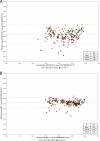Development of a second version of the Cobas AmpliPrep/Cobas TaqMan hepatitis C virus quantitative test with improved genotype inclusivity
- PMID: 21752967
- PMCID: PMC3165622
- DOI: 10.1128/JCM.00602-11
Development of a second version of the Cobas AmpliPrep/Cobas TaqMan hepatitis C virus quantitative test with improved genotype inclusivity
Abstract
Hepatitis C virus (HCV) RNA measurement has been facilitated by the introduction of real-time PCR-based assays with low limits of detection and broad dynamic ranges for quantification. In the present study, the performance of two second-version prototypes of the Cobas AmpliPrep/Cobas TaqMan HCV Quantitative Test (CAP/CTM v2) with decreased sample input volume and improved genotype inclusivity was investigated. A total of 232 serum and plasma samples derived from patients with chronic hepatitis C (genotype 1 [GT1], n = 108; GT2, n = 8; GT3, n = 24; GT4, n = 87; GT5, n = 3; and GT6, n = 2) were processed in parallel with the Cobas AmpliPrep/Cobas TaqMan HCV Test (CAP/CTM), Cobas Amplicor HCV Monitor Test v2.0 (CAM), and two second-version prototype formulations of CAP/CTM, Mastermix 1 (MMx1) and MMx2. In addition, three GT4 transcripts containing rare variant sequences were tested. The mean log(10) HCV RNA differences for the best-performing CAP/CTM v2/MMx2 formulation in comparison to CAM were -0.05, 0.05, -0.12, -0.10, -0.44, and -0.29 for patients with GT1, GT2, GT3, GT4, GT5, and GT6 infections, respectively. GT1, GT2, and GT4 samples including isolates with known variants within the 5' untranslated region (G145A, A165T) that were underquantified with CAP/CTM were correctly quantified with the second-version prototype. In addition, CAP/CTM v2 was able to accurately quantify the three transcripts with rare variant sequences. In conclusion, CAP/CTM v2 accurately quantifies HCV RNA across all HCV genotypes, including specimens with rare polymorphisms previously associated with underquantification.
Figures




References
-
- Akhavan S., Ronsin C., Laperche S., Thibault V. 2011. Genotype 4 hepatitis C virus: beware of false-negative RNA detection. Hepatology 53: 1066–1067 - PubMed
-
- Chevaliez S., Bouvier-Alias M., Brillet R., Pawlotsky J. M. 2007. Overestimation and underestimation of hepatitis C virus RNA levels in a widely used real-time PCR-based method. Hepatology 46: 22–31 - PubMed
-
- Chevaliez S., Bouvier-Alias M., Castera L., Pawlotsky J. M. 2009. The Cobas AmpliPrep-Cobas TaqMan real-time PCR assay fails to detect hepatitis C virus RNA in highly viremic genotype 4 clinical samples. Hepatology 49: 1397–1398 - PubMed
-
- Chevaliez S., Pawlotsky J. M. 2009. How to use virological tools for optimal management of chronic hepatitis C. Liver Int. 29 (Suppl. 1): 9–14 - PubMed
-
- Craxi A. 2011. EASL clinical practice guidelines: management of hepatitis C virus infection. J. Hepatol. 55:245–264 - PubMed
Publication types
MeSH terms
Substances
LinkOut - more resources
Full Text Sources
Medical
Miscellaneous

